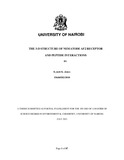The 3-d structure of nematode AF2 receptor and peptide interactions

View/
Date
2013-07Author
Jones, Lynett K
Type
ThesisLanguage
enMetadata
Show full item recordAbstract
The AF2 receptor belongs to the super family of G - protein coupled receptor that are of
great significance in the development of potent drugs for the treatment of parasitic nematodes
affecting people, especially school going children in developing countries. An accurate
evaluation of the peptide binding site into the receptor, at molecular level, may playa key role in
the design of new molecules with desirable properties and reduced side effects. In this study, 3-D
structure of AF2 receptor was developed using the X-ray crystal structure of beta 2- adrenergic
and Adenosine A2Areceptors and MODELLER. The initial structure of the receptor was refined
computationally with energy minimization and molecular dynamic simulations using
GROMACS software. The AF2 peptide structure Lys-His-Glu- Tyr-Leu-Arg-Phe-Nl-L was
generated using Insight II software and energy minimized using the force field available in
.Discover studio. NMR restrained molecular dynamics was used to determine the solution
conformation of AF2. The resulting structure was docked into the optimized model and the
critical amino acids responsible for binding were identified. Docking calculations of the AF2
peptide showed that the N-terminus, helix 7and the extracellular domains of the AF2 receptor
defined its binding pocket. The receptor-ligand complexes ~ere stabilized by formation of
hydrogen bonds and hydrophobic interactions. Virtual screening studies were also performed on
the receptor using ZINC compounds and they were found to dock inside the receptors binding
side. Therefore, knowledge of the 3D structure and the binding pocket of the receptor, from
parasitic nematodes, could lead to structure-based design of non- peptide antagonists that prevent
binding of AF2 molecules. This would pave the way for the development of new drugs to control
nematodes.
Publisher
University of Nairobi Department Environmental Chemistry, University of Nairobi
